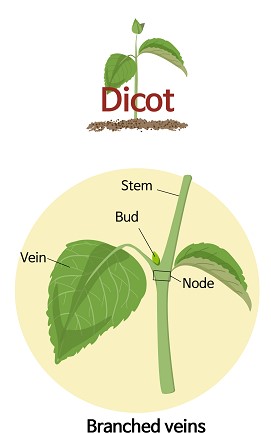PDF chapter test TRY NOW

Dicot leaf
If a plant is a dicot, then there are unique features for its leaf. For example, if seen externally, midrib and feather-like veins are seen on the leaf surface, which is different from that of a monocot leaf. Similarly, there are unique features for its internal structure also, which is explained in this topic.

Transverse section of dicot leaf
The above picture is showing a sector of the transverse section of a dicot leaf or dorsiventral leaf.
The following structures are seen in the section.
i. Upper epidermis:
It is the outermost layer present on the upper side of the leaf. It is a single layer of parenchymatous cells without intercellular spaces. The outer walls of the cells are covered with the protective layer, the cuticle. The number of stomata present in this layer is less.ii. Lower epidermis:
It is the outermost layer present on the lower side of the leaf. It is a single layer of parenchymatous cells without intercellular spaces. The outer walls of the cells are covered with a thin cuticle. A considerable number of stomata are present in this layer. Chloroplasts present only in bean-shaped guards cells, which surrounds the stomata openings. With the help of stomata, lower epidermis;
- Helps in the exchange of gases.
- Facilitates the loss of water vapour through the transpiration process.
iii. Mesophyll:
Between the upper and lower epidermis, there is an entire mass of ground tissue called mesophyll. It consists of two different kinds of parenchyma viz.,
- Palisade parenchyma
- Spongy parenchyma.
1. Palisade parenchyma:
This parenchyma present below the upper epidermis. These are elongated parenchymatous cells as they have more chloroplasts. So, these cells involved in the process of photosynthesis. The cells have very narrow intercellular spaces.
2. Spongy parenchyma:
Below the palisade parenchyma tissue, spongy parenchyma is present. Here, tissues are arranged irregularly with intercellular spaces. As a result, cells are mostly spherical or oval. This tissue also helps in gaseous exchange.
iv. Vascular bundles:
Vascular bundles occur at the midrib and veins of the leaf. Each vascular bundle consists of xylem and phloem and is surrounded by a sheath of cells made up of parenchyma called bundle sheath. The vascular bundle is conjoint, collateral and closed where the xylem is positioned towards the upper epidermis layer and the phloem is positioned towards the lower epidermis layer.Video explaining the internal structure of dicot leaf
